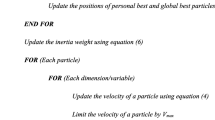Abstract
Multilevel thresholding is a very important image processing technique in the field of image segmentation. However, the computational complexity of determining the optimal threshold grows exponentially with increasing thresholds. To overcome this drawback, in this paper, we propose a multi-threshold image segmentation method based on the moth swarm algorithm. The meta-heuristic algorithm uses Kapur’s entropy method to optimize the thresholds for eight standard test images. When compared with other state-of-the-art evolutionary algorithms, the proposed method proved to be robust and effective according to numerical experimental results and image segmentation results. This indicates the high performance of the method for the segmentation of digital images.










Similar content being viewed by others
References
Bhandari AK, Singh VK, Kumar A, Singh GK (2014) Cuckoo search algorithm and wind driven optimization based study of satellite image segmentation for multilevel thresholding using Kapur’s entropy. Expert Syst Appl 41(7):3538–3560
Bhandari AK, Singh VK, Singh GK, Singh GK (2014) Cuckoo search algorithm and wind driven optimization based study of satellite image segmentation for multilevel thresholding using kapur's entropy. Expert Syst Appl 41(7):3538–3560
Develi I (2012) A new approximation based on the differential evolution algorithm for the gaussian q-function. Int J Innov Comput Inf Control Ijicic 8(10):7095–7102
Duraisamy SP, Kayalvizhi R (2010) A new multilevel thresholding method using swarm intelligence algorithm for image segmentation. J Intell Learn Syst Appl 2(3):126–128
El Aziz MA, Ewees AA, Hassanien AE (2017) Whale optimization algorithm and moth-flame optimization for multilevel thresholding image segmentation. Expert Syst Appl 83:242–256
Goldberg DE (1989) Genetic algorithms in search, optimization, and machine learning, Machine Learning,3:95-99
Hollander M, Wolfe DA, Chicken E (2014) Nonparametric statistical methods. Third Edition, John Wiley & Sons, Inc. Hoboken
Jiang Y, Tsai P, Hao Z, Cao L (2015) Automatic multilevel thresholding for image segmentation using stratified sampling and Tabu Search. Soft Comput 19(9):2605–2617
Kapur JN, Sahoo PK, Wong AK (1985) A new method for gray-level picture thresholding using the entropy of the histogram. Comput Vis Graph Image Process 29(3):273–285
Karaboga D (2005) An idea based on honey bee swarm for numerical optimization (Vol. 200). Technical report-tr06, Erciyes university, engineering faculty, computer engineering department
Kennedy J (2010) Particle Swarm Optimization, Encyclopedia of Machine Learning. Springer, US, 760-766
Khairuzzaman AKM, Chaudhury S (2017) Multilevel thresholding using grey wolf optimizer for image segmentation. Expert Syst Appl 86:64–76
Lai CC, Tseng DC (2004) A hybrid approach using gaussian smoothing and genetic algorithm for multilevel thresholding. Int J Hybrid Intell Syst 1(3–4):143–152
Liu Y, Zhang X, Cui J, Wu C, Aghajan H, Zha H (2010) Visual analysis of child-adult interactive behaviors in video sequences. In Virtual Systems and Multimedia (VSMM) International Conference on, IEEE pp 26–33
Liu Y, Cui J, Zhao H, Zha H (2012) Fusion of low-and high-dimensional approaches by trackers sampling for generic human motion tracking. In Pattern Recognition (ICPR) International Conference on, IEEE pp 898–901
Liu Y, Nie L, Han L, Zhang L, Rosenblum DS (2015) Action2Activity: recognizing complex activities from sensor data. In IJCAI, pp 1617–1623
Liu Y, Nie L, Liu L, Rosenblum DS (2016) From action to activity: Sensor-based activity recognition. Neurocomputing 181:108–115
Liu L, Cheng L, Liu Y, Jia Y, Rosenblum DS (2016) Recognizing Complex Activities by a Probabilistic Interval-Based Model. In AAAI, pp 1266–1272
Lu Y, Wei Y, Liu L, Zhong J, Sun L, Liu Y (2017) Towards unsupervised physical activity recognition using smartphone accelerometers. Multimed Tool Appl 76(8):10701–10719
Maitra M, Chatterjee A (2008) A hybrid cooperative–comprehensive learning based pso algorithm for image segmentation using multilevel thresholding. Expert Syst Appl 34(2):1341–1350
Mohamed AAA, Mohamed YS, El-Gaafary AA, Hemeida AM (2017) Optimal power flow using moth swarm algorithm. Electr Power Syst Res 142:190–206
Otsu N (2007) A threshold selection method from gray-level histograms. IEEE Trans Syst Man Cybern 9(1):62–66
Pal NR, Pal SK (1993) A review on image segmentation techniques. Pattern Recogn 38(9):1277–1294
Pun T (1980) A new method for grey-level picture thresholding using the entropy of the histogram. Signal Process 2(3):223–237
Sarkar S, Sen N, Kundu A, Das S, Chaudhuri SS (2013) A differential evolutionary multilevel segmentation of near infra-red images using Renyi’s entropy. In Proceedings of the International Conference on Frontiers of Intelligent Computing: Theory and Applications (FICTA) Springer, pp 699–706
Shore J, Johnson R (1980) Axiomatic derivation of the principle of maximum entropy and the principle of minimum cross-entropy. ieee trans. inform. theory it-26, 26-37. IEEE Trans Inf Theory 26(1):26–37
Storn R, Price K (1997) Differential evolution–a simple and efficient heuristic for global optimization over continuous spaces. J Glob Optim 11(4):341–359
Wang R, Zhou Y, Zhao C, Wu H (2015) A hybrid flower pollination algorithm based modified randomized location for multi-threshold medical image segmentation. Biomed Mater Eng 26(Suppl 1):S1345
Yang XS (2010) A new metaheuristic bat-inspired algorithm. Comput Knowl Technol 284:65–74
Yang XS (2013) Multiobjective firefly algorithm for continuous optimization. Eng Comput 29(2):175–184
Yen JC, Chang FJ, Chang S (1995) A new criterion for automatic multilevel thresholding. IEEE Trans Image Process 4(3):370–378
Yin PY (1999) A fast scheme for optimal thresholding using genetic algorithms. Signal Process 72(2):85–95
Acknowledgments
This work was supported by the National Science Foundation of China under Grant No. 61463007 and the Project of the Guangxi Natural Science Foundation under Grant No. 2016GXNSFAA380264. We thank Maxine Garcia, PhD, from Liwen Bianji, Edanz Group China (www.liwenbianji.cn/ac) for editing the English text of a draft of this manuscript.
Author information
Authors and Affiliations
Corresponding author
Rights and permissions
About this article
Cite this article
Zhou, Y., Yang, X., Ling, Y. et al. Meta-heuristic moth swarm algorithm for multilevel thresholding image segmentation. Multimed Tools Appl 77, 23699–23727 (2018). https://doi.org/10.1007/s11042-018-5637-x
Received:
Revised:
Accepted:
Published:
Issue Date:
DOI: https://doi.org/10.1007/s11042-018-5637-x




